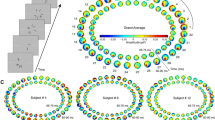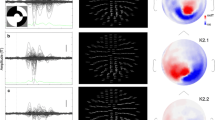Abstract
Visual evoked magnetic responses were recorded to full-field and left and right half-field stimulation with three check sizes (70′, 34′ and 22′) in five normal subjects. Recordings were made sequentially on a 20-position grid (4 × 5) based on the inion, by means of a single-channel direct current-Superconducting Quantum Interference Device second-order gradiometer. The topographic maps were consistent on the same subjects recorded 2 months apart. The half-field responses produced the strongest signals in the contralateral hemisphere and were consistent with the cruciform model of the calcarine fissure. Right half fields produced upper-left-quadrant outgoing fields and lower-left-quadrant ingoing fields, while the left half field produced the opposite response. The topographic maps also varied with check size, with the larger checks producing positive or negative maximum position more anteriorly than small checks. In addition, with large checks the full-field responses could be explained as the summation of the two half fields, whereas full-field responses to smaller checks were more unpredictable and may be due to sources located at the occipital pole or lateral surface. In addition, dipole sources were located as appropriate with the use of inverse problem solutions. Topographic data will be vital to the clinical use of the visual evoked field but, in addition, provides complementary information to visual evoked potentials, allowing detailed studies of the visual cortex.
Similar content being viewed by others
References
Halliday AM, Barrett G, Halliday E, Michael WF. The topography of the pattern-evoked potential. In: Desmedt JE, ed. Visual evoked potentials in man. Oxford: Clarendon Press, 1977: 121–33.
Barrett G, Blumhardt L, Halliday AM, Halliday E, Kriss A. A paradox in the lateralisation of the visual evoked response. Nature 1976; 261: 253–5.
Harding GFA, Smith GS, Smith PA. The effect of various stimulus parameters on the lateralisation of the visual evoked potential. In: Barber C, ed. Evoked potentials. Lancaster, England: MTP Press Ltd., 1980: 213–8.
Meredith JT, Celesia GG. Pattern-reversal visual evoked potentials and retinal eccentricity. Electroencephalogr Clin Neurophysiol 1982; 53: 243–53.
Spalding JMK. Wounds of the visual pathway, Part II: The striate cortex. J Neurol Neurosurg Psychiatry 1952; 15: 169–83.
Brecelj J, Cunningham K. Occipital distribution of foveal half-field responses. Doc Ophthalmol 1985; 59: 157–65.
Lehmann D, Dorcey TM, Skrandies W. Intracerebral and scalp fields evoked by hemiretinal checkerboard reversal and modelling of their dipole generators. In: Courjon J, Mauguière F, Revol M, eds. Clinical applications of evoked potentials in neurology. New York: Raven Press, 1982: 41–8.
Flanagan JG, Harding GFA. Source derivation of the visual evoked potential. Doc Ophthalmol 1986; 62: 97–105.
Wikswo JP. Biomagnetic sources and their models. In: Williamson SJ, Hoke M, Stroink G, Kotani M, eds. Advances in biomagnetism. New York: Plenum Press, 1989: 1–18.
Cohen D, Cuffin BN. Demonstration of useful differences between MEG and EEG. Electroencephalogr Clin Neurophysiol 1983; 56: 38–51.
Teyler TJ, Cuffin BN, Cohen D. The visual evoked magnetoencephalogram. Life Sci. 1975; 17: 683–92.
Brenner D, Williamson SJ, Kaufman L. Visually evoked magnetic fields of the human brain. Science 1975; 190: 480–1.
Stok CJ. The inverse problem in EEG and MEG with application to visual evoked responses [PhD thesis] Leiden University, 1986.
Richer F, Barth DS, Beatty J. Neuromagnetic localisation of two components of the transient visual evoked response to patterned stimulation. Nuovo Cimento 1983; 2d(2): 421–8.
Janday BS, Swithenby SJ, Thomas IM. Combined magnetic field and electrical potential investigation of the visual pattern reversal system. In: Kotani M, Katila T, Williamson SJ, Ueno S, eds. Biomagnetism. Tokyo: Denkai Press, 1989: 246–9.
Melcher JR, Cohen D. Dependence of the magnetoencephalogram on dipole orientation in the rabbit head. Electroencephalogr Clin Neurophysiol 1988; 70: 460–72.
Armstrong RA, Harding GFA, Slaven A, Furlong P, Janday B. Normative MEG data to flash and pattern reversal stimuli. Electroencephalogr Clin Neurophysiol 1990; 75: 1–3P.
Janday BS. Biomagnetic field measurements and their interpretation using the dipole in a sphere model [PhD thesis] Open University, Milton Keynes, 1987.
Janday BS, Swithenby SJ. The use of the symmetric sphere model in magnetoence-phalographic analysis. In: Erne SN, Romani GL, eds. Advances in biomagnetic functional localisation. A challenge for biomagnetism. Singapore: World Scientific, 1989: 153–60.
Novak GP, Wiznitzer M, Kurtzberg D, Gresser BS, Vaughan HG. The utility of visual evoked potentials using hemifield stimulation and several check sizes in the evaluation of suspected multiple sclerosis. Electroencephalogr Clin Neurophysiol 1988; 71: 1–9.
Steinmetz H, Fürst G, Meyer B. Craniocerebral topography within the international 10–20 system. Electroencephalogr Clin Neurophysiol 1989; 72: 499–506.
Okada Y. Neurogenesis of evoked magnetic fields. In: Williams SJ, Romane G, Kaufman L, Modena I, eds. Biomagnetism. An interdisciplinary approach. New York: Plenum Press, 1983: 399–408.
Haimovic IC, Pedley TA. Hemifield pattern reversal visual evoked potential. II. Lesions of the chiasm and posterior visual pathways. Electroencephalogr Clin Neurophysiol 1982; 54: 121–31.
Ducati A, Fava E, Motti EDF. Neuronal generators of the visual evoked potentials. Intracerebral recording in awake humans. Electroencephalogr Clin Neurophysiol 1988; 71: 89–99.
Strude M, Prevec TS, Zidar I. Dependence of visual evoked potentials on change of stimulated retinal area associated with different pattern displacements. Electroencephalogr Clin Neurophysiol 1982; 53: 634–42.
Adachi-Usami E, Lehmann D. Monocular and binocular averaged potential field topography. Upper and lower hemiretinal stimuli. Exp Brain Res 1983; 50: 341–6.
Butler SR, Georgiou GA, Glass A, Hancox RJ, Hoper JM, Smith KRH. Cortical generations of the C1 component of the pattern-onset visual evoked potential. Electroencephalogr Clin Neurophysiol 1987; 68: 256–67.
Ossenblok P, Spekreijse H. The extrastriate generators of the EP to checkerboard onset. A source localization approach. Electroencephalogr Clin Neurophysiol 1991; 80: 181–93.
Author information
Authors and Affiliations
Rights and permissions
About this article
Cite this article
Harding, G., Janday, B. & Armstrong, R. The topographic distribution of the magnetic P100M to full- and half-field stimulation. Doc Ophthalmol 80, 63–73 (1992). https://doi.org/10.1007/BF00161232
Accepted:
Issue Date:
DOI: https://doi.org/10.1007/BF00161232




